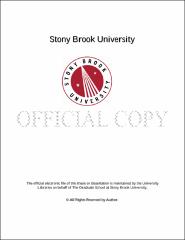| dc.identifier.uri | http://hdl.handle.net/11401/76106 | |
| dc.description.sponsorship | This work is sponsored by the Stony Brook University Graduate School in compliance with the requirements for completion of degree. | en_US |
| dc.format | Monograph | |
| dc.format.medium | Electronic Resource | en_US |
| dc.language.iso | en_US | |
| dc.publisher | The Graduate School, Stony Brook University: Stony Brook, NY. | |
| dc.type | Dissertation | |
| dcterms.abstract | Porous media, such as rocks and soil, make up the largest proportion of mass in nature. Pore-network model is a widely used model to describe the tiny and complicated inner structure of porous media. Assisted by the development of X-ray computed microtomography in recent years, researchers are able to extract the geometric characters of inner pores and throats from porous media, then further explore two-phase flow in porous media more exactly. Drainage, a process that a non-wetting phase fluid replaces the other wetting fluid, is the research topic of this thesis. The boundaries between two different phases, named as menisci consisting of arcs with same radii, are formed by surface tension between two phases. A greedy-type method is presented to calculate the arc-meniscus at entry pressure for drainage into the cross section of an infinitely long capillary tube under arbitrary wetting angle in the range [0,&pi/2). By the greedy method we construct counterclockwise(CC) circuits which represent the different non-wetting regions, then the entry radius of a cross section could be achieved by comparing different entry radii of the corresponding CC-circuits. In addition, we can also extract the drainage axis of a polygon with a wetting angle in the range [0,&pi/2) by the greedy method. We obtain the entry radii from 23,639 throat polygons derived from the 3D analysis of tomography images of a Fontainebleau sand- stone sample having 22% porosity. Then we derive an empirical formula, which considers the effects of area A, perimeter P, wetting angle &theta and the number of polygon edges n, to estimate the entry radius for any arbitrary polygon. With the simplification of the formula, our results also show that the ratio, A/(P · cos &theta), is a good estimator of the entry radius within 5% error on average for Fontainebleau samples. | |
| dcterms.available | 2017-09-20T16:42:21Z | |
| dcterms.contributor | Lindquist, W. Brent | en_US |
| dcterms.contributor | Samulyak, Roman | en_US |
| dcterms.contributor | Orlov, Alexander. | en_US |
| dcterms.contributor | Li, Xiaolin | en_US |
| dcterms.creator | Li, Long | |
| dcterms.dateAccepted | 2017-09-20T16:42:21Z | |
| dcterms.dateSubmitted | 2017-09-20T16:42:21Z | |
| dcterms.description | Department of Applied Mathematics and Statistics. | en_US |
| dcterms.extent | 88 pg. | en_US |
| dcterms.format | Monograph | |
| dcterms.format | Application/PDF | en_US |
| dcterms.identifier | http://hdl.handle.net/11401/76106 | |
| dcterms.issued | 2014-12-01 | |
| dcterms.language | en_US | |
| dcterms.provenance | Made available in DSpace on 2017-09-20T16:42:21Z (GMT). No. of bitstreams: 1
Li_grad.sunysb_0771E_11986.pdf: 1251724 bytes, checksum: 2c23d2f4eaf556c2e1deed86566320c7 (MD5)
Previous issue date: 1 | en |
| dcterms.publisher | The Graduate School, Stony Brook University: Stony Brook, NY. | |
| dcterms.subject | drainage, entry pressure, entry radius, network flow models, wetting films | |
| dcterms.subject | Applied mathematics | |
| dcterms.title | A greedy method to simulate drainage in cross sections | |
| dcterms.type | Dissertation | |

